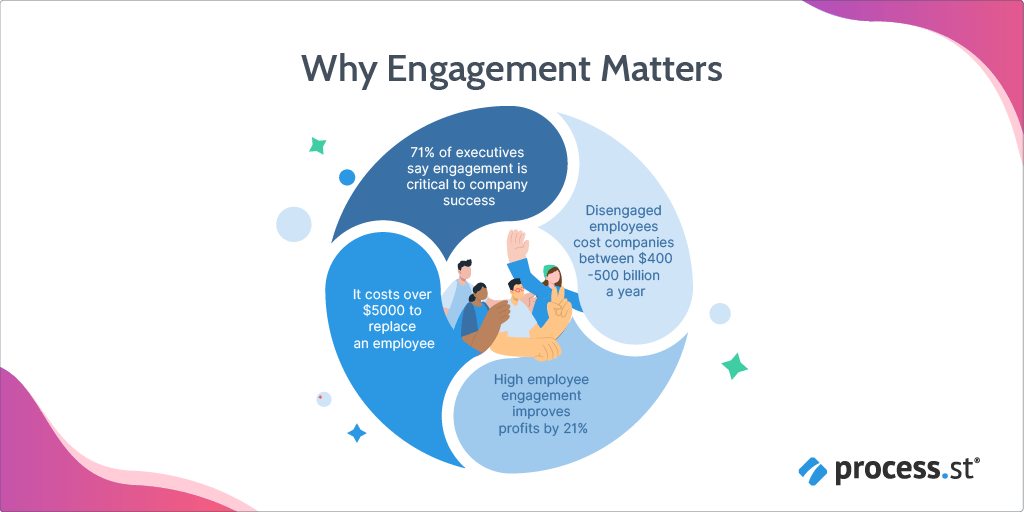
Employees are the lifeblood of any business or any brand the whole world over.
It doesn’t matter if it’s two part-time staff metalworking from a family garage or 1,000 employees in a multinational virtual law firm, employee performance is your business’ performance.
As a result, when employees are unengaged and working sub-par, so is your business.
Under-engaged employees will affect the overall success of your business and poor morale quickly spreads. It’s therefore a good idea to nip it in the bud as soon as possible.
To help you learn how, I’ll be walking you through:
- It’s your duty to help employees succeed
- How to know if my employees are struggling to be engaged
- 7 ways to motivate your disengaged employees
It’s your duty to help employees succeed
The biggest mistake a manager can make is assuming that all of their employees can read their mind.
When making this mistake, managers, as well as HR teams, assume that staff who aren’t performing as expected must be doing so knowingly. This can elicit a poor working relationship before any conversation has even taken place.
Before engaging the employee in some way or another through the following seven steps, first, spend some time figuring out whether or not you as a manager have provided everything this employee needs to be successful in their role.
It’s important to ask yourself the following questions when trying to assess if the issue really lies with the employee:
“Has this employee been adequately trained?”
It’s been claimed that up to 59% of employees feel that their training was inadequate and most of their skills were self-taught. When employees aren’t imparted with the skills for success, there is a good chance they won’t succeed. Poor training almost always results in poor engagement.
Ensure your training programmes are sufficient before pointing any fingers. If your employee’s role is transitioning brands to cloud communication, they probably don’t need to be trained on the origin of the computer bug.
“Am I being reasonable in what I am asking of them?”
One of the biggest reasons for poor engagement at work is overworking. Employees that are being asked to do more than they are capable of will always suffer in terms of morale. A friendly check-in with an under-engaged employee can help you avoid overworking your employees.
Once you have taken the time to answer these questions, you should have a better idea as to whether or not the issue truly lies with the employee.
As a manager or team leader, it’s your responsibility to do whatever you can to get the best from your employees. Ensuring you aren’t the source of the engagement issue better informs you to help get the best from them.
It’s easy to get creative with this task by writing the things you have already done to encourage the employee on one color Post-It note and things you could do on another. Being able to actually see both sides will help you decide if you have done enough.
How to know if my employees are struggling to be engaged
It may sound like an easy question to answer, but when we actually think about it, it kind of isn’t.
Sure, there are a few obvious pointers to an under-engaged employee, such as negative body language and struggling to complete tasks. Does this mean that employees who have a smile on their face and can complete tasks are fully engaged? Don’t be so sure.
In order to find out whether or not your employees are fully motivated, you need to take the time to:
- Track their performance : Look for signs of a decline in productivity. This will be different in each job role and industry, it could be a drop off in sales or simply completing fewer tasks per shift.
- Ask them how they feel : If you find signs of productivity decline or not, sitting down with an employee one-to-one and asking how they are at work is the best way to assess if they are engaged or not.
Now you know whether or not your employees are struggling to be motivated at work, it’s time to implement a creative solution to get the best for both them and your business!
7 ways to motivate your disengaged employees

1. Make your employees feel heard
Let’s start with the easiest of all of the tips in this guide, simply acknowledging staff when you first see them and asking them how they are. This can take only a few seconds, but the significance of it can’t be overstated.
A friendly ‘Good morning’ accompanied by a smile lets employees know you see them and value them. You can’t control employees’ interactions outside of work but you can set a positive atmosphere in the workspace.
For what takes only a few seconds, why wouldn’t you?
2. Awaken their sense of purpose
It’s been shown time and time again that people who ‘live their purpose’ at work are more productive than those who don’t.
People whose employment doesn’t offer the chance to develop aren’t going to show the levels of motivation and commitment of those who can grow at work.
It’s all well and good knowing that employees will be more motivated when they can develop personally at work, but how do you as a manager encourage that? In order to be able to answer that question, you’ll need to reach out to the under-engaged employee and find out how you can support their growth.
For example, if you own and operate a marketing start-up and an unmotivated employee wants to develop their sales through better communication, don’t give them the affiliate marketing for dummies.
Instead encourage their development through personal coaching with a senior sales rep, or consider external coaching for their development.
3. Boost their morale by acknowledging the small wins
In most cases, employees who are under-engaged and under-performing will still have some things they are doing well.
So often, poor performance is a sign of low self-esteem and a verbal pat on the back can work wonders in improving an employee’s confidence.
Something so simple as “I was impressed with how you finalized that sale today,” or “I’ve noticed our call center performance improvement, you were a part of that,” can go a long way to motivating an employee to work harder for more encouragement and recognition.
It’s been found that 31% of employees value positive feedback most from colleagues against 26% who prefer it from superiors. Therefore, encouraging a culture of positive feedback among team members is essential to boosting morale and engaging unmotivated employees.
Focusing on the positives, especially those small wins, is a great way to take an employee out of a place of disengagement and boost their morale.
4. Create a tailor-fit employee benefits and compensation package
People work because work gives them money which they need to get by in life. Groundbreaking stuff I know, but hear me out.
If we recognise that employees are working, among other things, for a better financial situation, it makes sense that offering financial incentives will boost motivation.
While this might at first seem like I’m suggesting that you increase wages or performance-based bonuses, that’s only really part of it. A fantastic way to ease the cost of living for employees is to offer personalized benefits packages. This requires sitting down with employees and figuring out where their priorities are.
Consider adding little extras to benefits packages, beyond simply the typical dental and vision. Maybe offer employees discounts with sister brands, perhaps a free VoIP phone number for home, or a gaming subscription. Why not a boost to their points scheme at their local grocery chain?
The fact you take the time to sit down with employees and ask them what they want goes a long way to show that you care about them as individuals. Employees treated as individuals are likely to show the same care for their work. Personalizing employee experience should ideally begin at onboarding and continue throughout their time at the business.
5. Encourage taking regular breaks and flexible working hours
While on the topic of treating your employees as individuals, offering working hours that suit them is a great way to boost morale and by extension, productivity. This is more feasible for some businesses than others, but where possible should always be considered.
If, for example, an employee has young children, it may make their life easier allowing their shifts to end before 3PM so they can pick them up from school. If they volunteer at a homeless shelter on Saturday evenings, swap their Saturday shifts for a day midweek.
While this might seem like a lot of effort on your part (scheduling is hard enough as it is!), the benefits can far outweigh the drawbacks. Showing you care enough to give shift patterns that work, encourages employees to reciprocate the effort. Be sure to implement flexible shift and workflow patterns into your team management client.
Alongside flexible shift patterns, simply offering more breaks during work can also give employees the time they need to recharge and go back to a task 100%.
6. Strategize a fun way to evaluate their performance reviews
Performance reviews are often a time of high anxiety.
Managers are anxious about giving constructive feedback that can be misconstrued. Employees are anxious about their job security and pay.
A great way to make performance reviews more positive is to flip the process around and have employees give their own perspectives of their performance. Give employees a week’s notice before the review and let them present to you what is working well and what could improve.
7. Invest time in providing regular ice-breakers
Another great way to motivate under-engaged employees is to provide weekly ‘ice-breakers’, or team meetings.
These are common practices in some parts of the world, such as China, where it’s a regular sight to see store’s teams outside stretching together before work, which always results in laughter and smiles on faces.
Ice-breakers that are unrelated to work, like stretching, are a nice way to associate work with something lighthearted and fun. A boost of positivity before a shift can really contribute to employees’ overall well-being and emotional intelligence.
Disengaged employees: Their motivation is your success
Improving employee motivation and happiness in the workplace has been shown to have a direct impact on business performance.
Providing employees with a sense of purpose at work, focusing on their strengths, and treating them as individuals goes a long way to uplifting both their well-being and your brand.
Do you struggle with disengaged employees in your organization? What have you found to help motivate them? Let us know in the comments below!

Grace Lau is the Director of Growth Content at Dialpad, an AI-powered cloud communication platform for easier team collaboration and best practices for contact centers. She has over 10 years of experience in content writing and strategy. Currently, she is responsible for leading branded and editorial content strategies, partnering with SEO and Ops teams to build and nurture content.







 Workflows
Workflows Projects
Projects Data Sets
Data Sets Forms
Forms Pages
Pages Automations
Automations Analytics
Analytics Apps
Apps Integrations
Integrations
 Property management
Property management
 Human resources
Human resources
 Customer management
Customer management
 Information technology
Information technology



Oliver Peterson
Oliver Peterson is a content writer for Process Street with an interest in systems and processes, attempting to use them as tools for taking apart problems and gaining insight into building robust, lasting solutions.